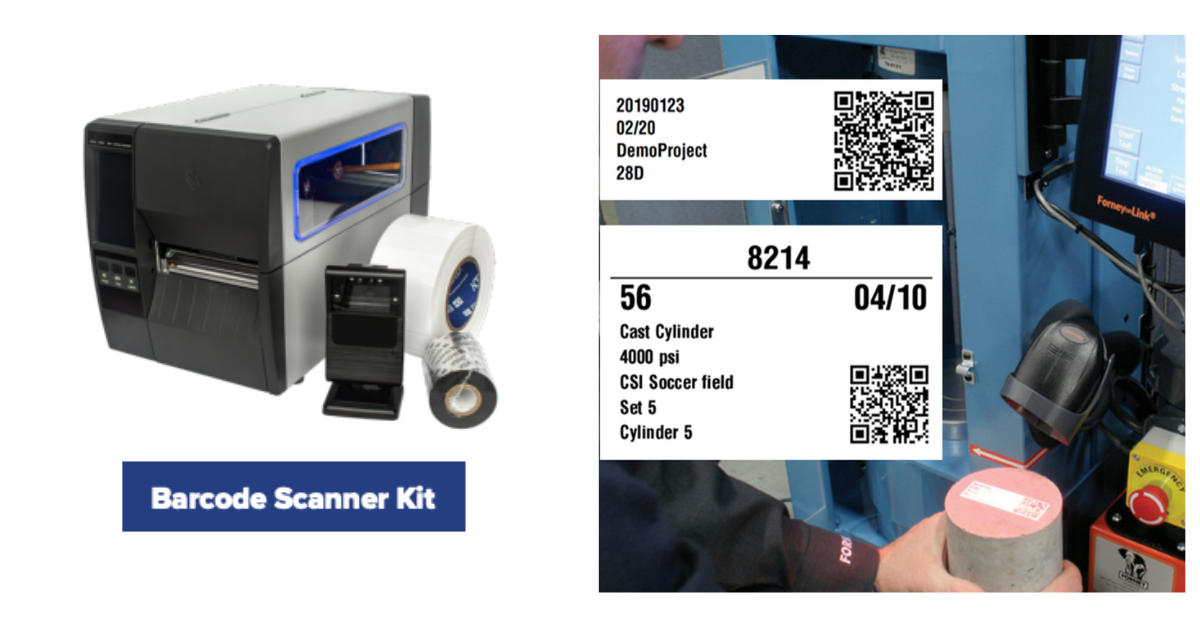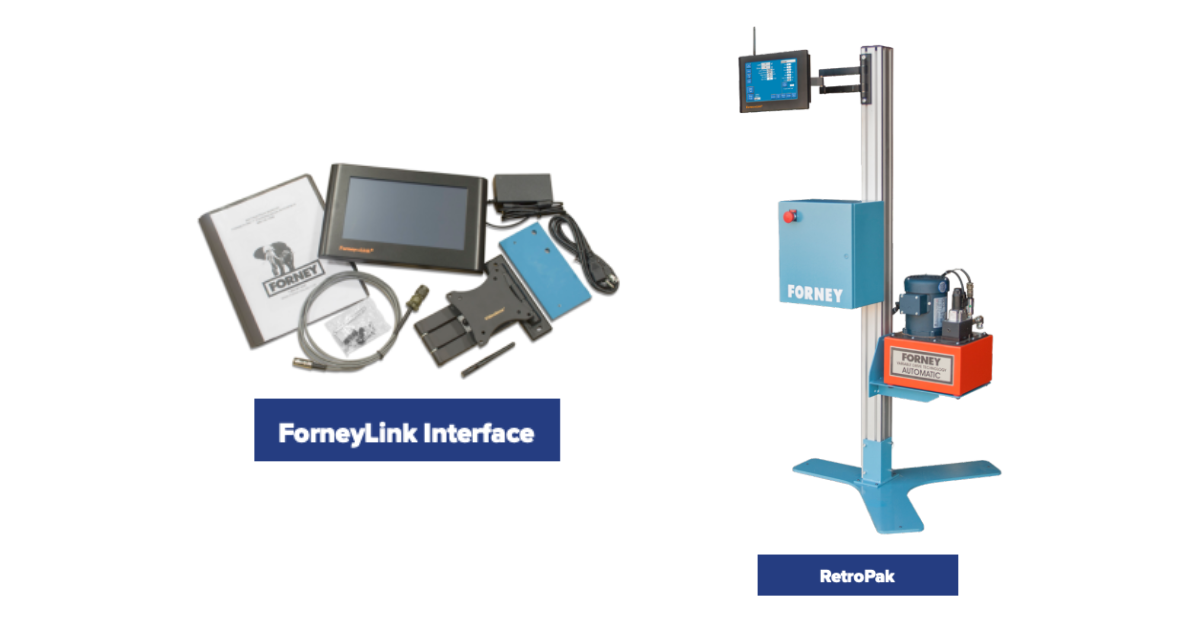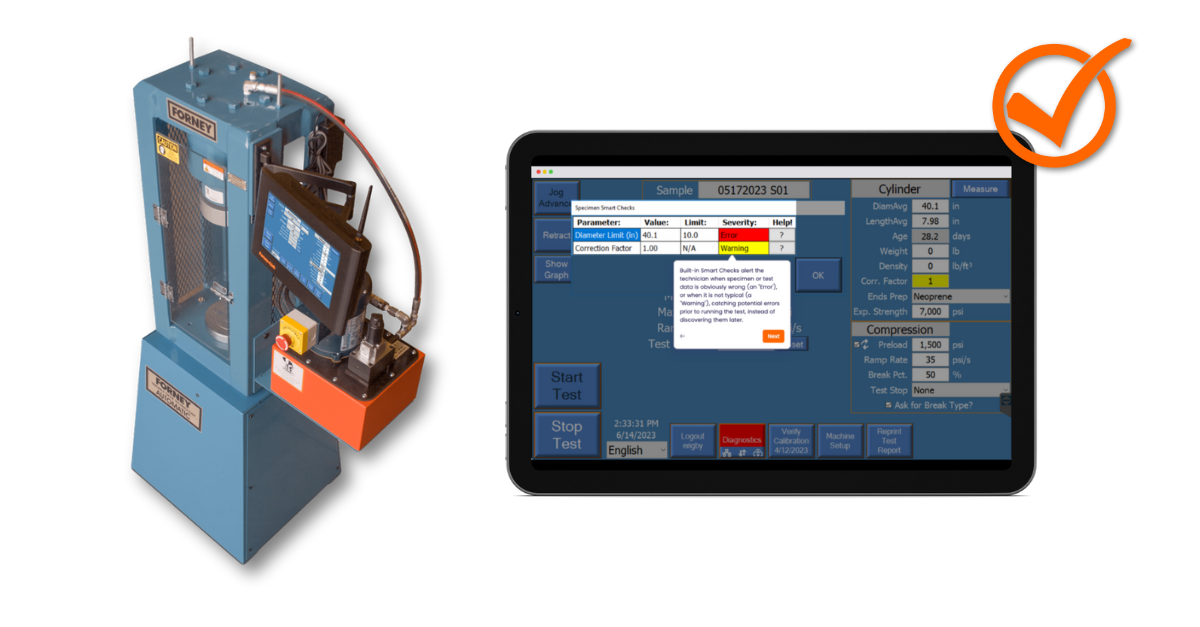Are you testing the right specimen on the right day with the right parameters? Even the most seasoned technician can benefit from a built-in validation step. Here’s why—and what these checks can look like.
Material testing machines have come a long way since their invention. As manual machines phase out in favor of the greater precision and speed automatic machines have to offer, testing labs are hitting faster milestones and even better standards of quality.
But even the most advanced machines need the right checks in place to ensure every test is accurate and compliant. Even one incorrect parameter can distort results, jeopardizing project timelines, budgets, and long-term performance.
This puts a lot of pressure on not only the process but also the machine technician managing it all. While (mostly) gone are the days of rate adjustments and other heavy lifting required by manual machines, automatic machines still demand setup that accumulates quickly, whether you’re a small lab handling it all yourself or a large lab managing hundreds of cylinders daily.
Here’s how Smart Checks—powered by a Connected Testing Machine—can help lighten the load.
Related Reading: Manual vs. Automatic vs. Connected Material Test Machines
What Are Material Testing Machine Smart Checks?
A Smart Check is an automated verification step that reviews key test details to ensure the information matches expected standards, preventing errors. These checks use preloaded sample and specimen data to confirm that critical parameters align with expectations.
Smart Check #1. Sample Date
Concrete gains strength over time through curing, and standardized testing happens at specific curing milestones: Typically at 7, 14, and 28 days. Each milestone corresponds to a different expected strength level – and a different expectation on the jobsite.
Testing too early or too late can yield results that don’t accurately reflect the concrete’s performance at the intended age, leading to faulty assumptions about its quality and safety. For example, testing a 28-day sample before it has fully cured could underestimate strength, causing unnecessary project delays or costly retesting. Testing too late might mask underperforming concrete that should have been caught earlier.
A Smart Check that validates the sample date ensures the test matches the correct curing age, maintaining the integrity and relevance of the test results within the project timeline.
Smart Check #2. Specimen Size & Type
Testing standards and machine settings are based on specific specimen dimensions and materials. Concrete cylinders, for example, come in standard sizes like 4×8 inches or 6×12 inches with different testing parameters depending on which size you’re using.
If the specimen size or type is incorrect or mismatched, it can cause several issues:
- Inaccurate strength readings: Different sizes have different failure modes and surface areas, affecting calculated strength values.
- Non-compliance: Many industry standards and project specifications require testing specific specimen sizes or types based on factors like nominal aggregate size, so deviations can lead to rejected results or failed inspections.
- Machine calibration errors: Testing a specimen with incorrect settings will result in improper loading rates, making the result invalid and destroying a specimen that cannot be recreated.
Smart Checks verify that the specimen size and type entered into the system match the preloaded data, ensuring the machine applies the correct test parameters. This prevents operator errors like testing a 4×8 specimen with settings for a 6×12.
Smart Check #3: Specimen Geometry
Similarly, it’s important to check the shape and dimensional accuracy of the test specimen, including diameter, height, and surface flatness.
Compressive strength is calculated using the load at failure divided by the cross-sectional area. If the geometry is off (e.g., diameter entered as 4″ when it’s actually 6″), the calculated strength will be completely inaccurate. Testing a cylinder as though it’s a cube is even worse.
If a specimen isn’t perfectly flat or perpendicular to the testing machine, the applied force will be uneven or off-center, resulting in uneven stress distribution, or even equipment damage.
Smart Checks validate specimen geometry against the preloaded project or sample data to ensure accurate setup and calculations. They also enable planeness and perpendicularity checks. This helps avoid invalid tests and ensures consistent, trustworthy data.
Smart Check #4: Expected Strength
The expected strength or design strength of the concrete mix provides a baseline range for the test and is often tied to project specifications or design requirements. This expectation helps determine whether the material meets structural and safety standards.
If the expected strength is wrong, the test results may be misinterpreted or rejected. In a worst-case scenario, this could lead to structural deficiencies going unnoticed or unnecessary construction delays due to false failures.
Smart Checks compare the entered expected strength to the project data to catch discrepancies before the test begins, and notify the technician of underperforming results after the test, keeping the test aligned with the material’s actual performance requirements.
Smart Check #5: Preload Calculations
Preload refers to the initial force applied to a specimen before the actual test begins. It ensures the specimen is properly seated between the platens, eliminates gaps or slack, and helps prevent shock loading that could affect the results or damage equipment. For some test standards, it makes the testing process more efficient by maximizing speed early in the test.
If preload values are inaccurate, it could affect the starting conditions, skewing the test results or damaging the specimen. Too much preload can crack a weak specimen before the test even starts; too little can introduce instability or cause slippage.
Smart Checks automatically verify that preload settings match the expected values for the specimen type, test method, and concrete mix design. That way, each test starts from the right baseline.
How to Connect Smart Checks to Your Machine
By catching small errors before they become big problems, Smart Checks help keep your data clean and your projects on track. What does it take to get them up and running?
It’s called a Connected Machine: a type of material testing machine with a powerful, two-way integration with ForneyVault CMT software. This integration makes the machine “smart” by preloading it with sample and specimen data tied to unique identification.
Here’s how it works:
- ForneyVault creates a unique identifier for every specimen that’s cast in the field and ties it to the sample it came from.
- This ID can be turned into a barcode, which is printed on a label and applied to the specimen.
- At the machine, a technician can scan the barcode – thus initiating the “Smart Checks.”

But don’t worry: You don’t need to buy a new machine to enable Smart Checks. Here are your options:
- For manual machine owners: Connect to ForneyVault with the ForneyLink interface. Or, upgrade your controls to automatic with the Forney Retropak to take full advantage of the benefits (recommended).
- For automatic machine owners from other manufacturers: Add RetroPak to any automatic machine to enable ForneyVault.
- For Forney automatic machine owners: Add barcode capabilities (recommended) and subscribe to ForneyVault.
- If you need a new machine: Save $1,500 by getting it with Connected controls.

Conclusion
Smart Checks take automatic machines — and their operator — to the next level in terms of efficiency and accuracy. Gone are the days of premature breaks or specimen mismatches. With Smart Checks, you can always be sure that you are testing the right specimen on the right day with the right parameters.
Connected Machines – powered by ForneyVault CMT software – result in 99.9%+ fewer manual errors, 66%+ increase in productivity, and 100% unalterable, unquestionable data. Get a quote or get in touch to explore your options today.
